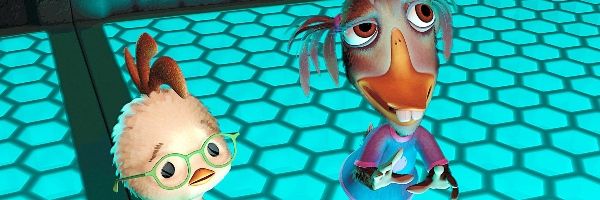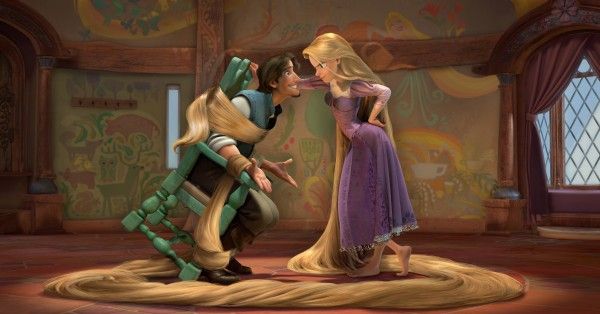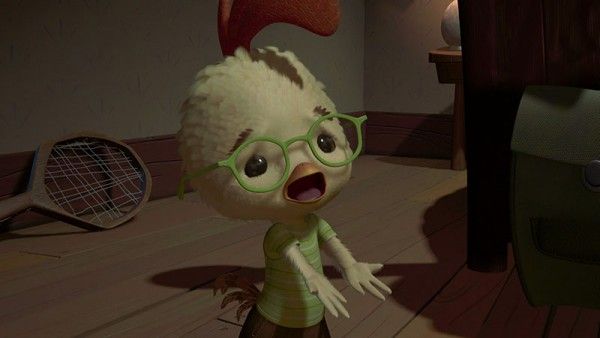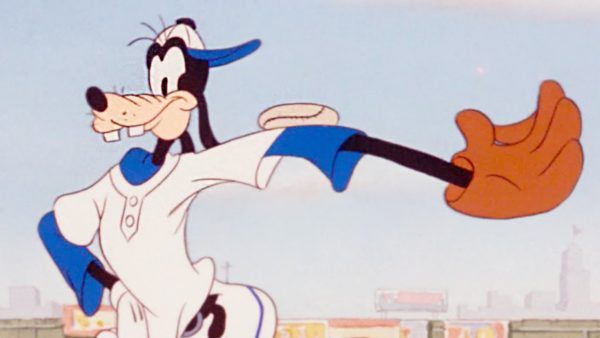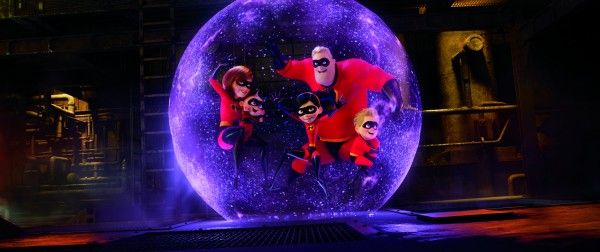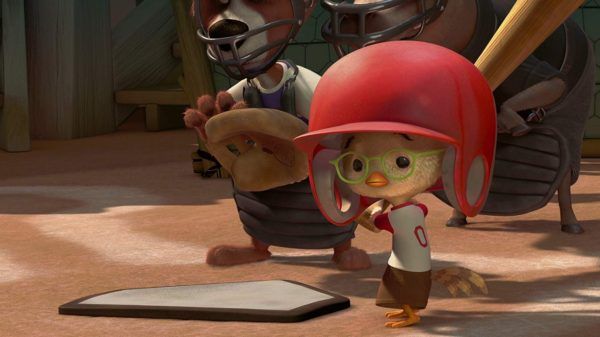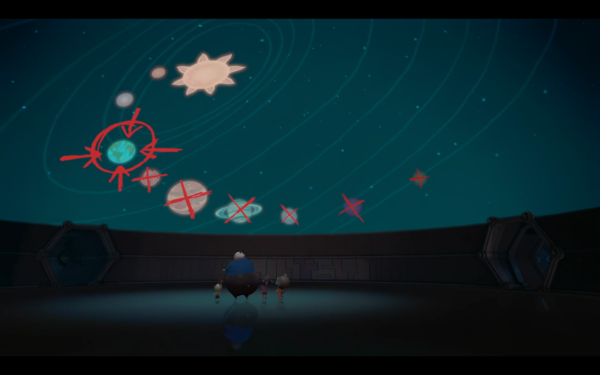15 years ago, Disney released its first feature-length computer-animated film. That’s a pretty huge milestone, one that should probably be celebrated, or at the very least remembered. But the movie that ushered in this new era of Walt Disney Animation, paving the way for such zeitgeist-capturing blockbusters as Frozen and Zootopia, has been all but forgotten. Chicken Little, released on November 4, 2005 (and now streaming on Disney+), might not have left a lasting impression but it should still be commemorated. After all, this was a Disney animated feature that somehow weathered several regime changes, constant creative interference, and an arms race for computer-animation dominance that saw the movie entirely shut down and reconceived halfway through production. This chicken was a survivor.
Shortly after the release of their equally fraught The Emperor’s New Groove, director Mark Dindal and producer Randy Fullmer embarked on a new project. They had done massive work overhauling a previous version of The Emperor’s New Groove and wanted to keep the irreverent spirit of that project but apply it to a concept that was all theirs. This time they would base it on the European folklore of Henny Penny, known here as Chicken Little, who thinks the sky is falling because they are standing under an acorn tree. “I think maybe that there was that idea of this time the sky really is falling popped into my head on a drive home. We pretty much started on it right away,” Dindal said in an exclusive interview with Collider looking back on the project. He then quickly admitted: “The early days on that are a little cloudy.”
Soon, a plot was hatched: this version would be all about Chicken Little (to be voiced by Oscar-winner Holly Hunter) and her relationship with her father (Garry Marshall). “I have two daughters, so I immediately went to a father/daughter story,” Dindal said. “The initial one, she was a very nervous, anxious little kid who was prone to panic attacks and overreacting. It was an acorn but in her mind it was the sky and it caused this big catastrophe in the town,” Dindal explained. Chicken Little wanted to make her dad proud, so she signed herself up for a summer camp (Dindal remembers the name being Camp Yesyoucan) to build her confidence. “When she went there, the really friendly sheep counselors had been abducted and wolves-in-sheep-clothing had taken over with the very silly idea to plump the kids up to cook them at the end for a big wolf feast. And she ends up saving the day,” Dindal said. This version had been developed for a couple of years (“It had been boarded and finished,” with Penn Gillette cast as the lead wolf) when Michael Eisner, former Chairman and CEO of Disney, made a request … or rather, a demand.
“Michael Eisner just said, ‘I don’t want it to be a girl, I want it to be a boy,’” Fullmer said in a separate interview with Collider. “There’s Mark with a couple of daughters and he as a director felt like I totally understand little girls, I know this. It’s like asking him to make a movie about African natives.” Dindal recalls that the suggestion was made, in part, due to some kind of market research that had been done by the studio (or at least that’s what they were telling the team). “I remember being told, ‘Girls will go see a movie with a boy protagonist but boys won’t see a movie with a girl protagonist,’” Dindal said. “That was the wisdom at the time, until Frozen comes out and makes $1 billion.” This excuse really doesn’t hold water when you account for how many of the breakthrough animated films both during the original run of animated classics (like Cinderella and Snow White and the Seven Dwarfs) and in the so-called Disney Renaissance of the 80s and 90s (like The Little Mermaid and Beauty and the Beast) were focused on female protagonists. And at the time that Chicken Little was in production, legendary Disney animator Glen Keane, was hard at work on Rapunzel Unbraided (a movie that would eventually become Tangled). They begrudgingly agreed. “After we switched it to a boy he seemed much happier with that choice and that direction,” Dindal said. One fire was doused; many more would spring up.
The gender-switch edict coincided with another seismic behind-the-scenes event, when Thomas Schumacher, who had been with Walt Disney Animation since 1990 and helped steer it through its creative rebirth (eventually becoming President of what was then known as Walt Disney Feature Animation in 1999), left to focus on Disney Theatrical Group, where he would oversee the company’s Broadway productions. In his place, the well-liked Schumacher installed David Stainton, who had been with Disney since 1989 and served in a variety of positions at different business units. Stainton made sweeping changes, including shuttering the studio’s Florida satellite studio (where such hits as Lilo & Stitch and Brother Bear had been produced) and focusing the studio exclusively on computer animation. And if Eisner’s demand that the lead character be swapped from a girl to a boy had paused the project, Stainton’s response led to a complete creative, from-the-ground-up overhaul.
“We had a screening for Eisner and it was David Stainton’s first day or second day. It’s the Hollywood thing where here he comes and he’s overseeing the movie and he has nothing invested in it,” Fullmer remembered. “So he has to burn it and start over in his vision. He was quite happy to describe it as a ‘train wreck.’ The air just went out of my sails. It was not a train wreck. It had a lot of charm to it.” ("I was sitting there at the screening room watching it and I thought: 'Oh my God! What am I going to do?"' Stainton told the New York Times, referring to being told that Chicken Little was in good shape. "This is the movie that's working? I honestly almost started to cry.") Later, Schumacher admitted to Fullmer that he knew about Eisner wanting to swap the gender of the main character and he thought that the decision, coupled with Stainton replacing him, would sink the movie completely. “He thought that it would, for sure, fold the movie,” Fullmer said. “And we would never do the movie. We would just give up.” But, somehow, the team didn’t give up – Fullmer describes them as “stubborn” and deeply protective of their crew – and offered to reconfigure the movie.
That's when Dindal thought back to an earlier iteration of the story, which focused on Chicken Little and a group of misfit animals who lived on a farm in the middle of the country. On the weekend of the country fair, the prize animals went off to win their ribbons while the reject animals stayed behind. “Aliens touched down in that remote area to begin their conquest of earth and she and the other animals thwart that. And there was no evidence. Since it happened in a remote location, the world would never know,” Dindal explained. “But at the beginning of the movie, they say to themselves ‘if we could only show these arrogant, blue-prize-winning animals that we’re just as good, if we could show them something, that would surprise them,’ but by the end of the movie when everyone comes back and waves their ribbons in their face, they just say, ‘Well that’s good.’ They realize they don’t need the approval of people like that. They feel good about themselves.” While no evidence remains of their extraterrestrial intervention, a security camera had been rolling all weekend and the farmer, after returning from the fair, pops in a VHS tape and is shocked at what he sees.
Dindal wound up combining the science fiction concept from this early idea with some of the character stuff from the wolf/summer camp version, into a new concept. In this Chicken Little, our titular hero (now voiced by Zach Braff) lives in a small town with his father (Marshall), has a freak-out that the sky is falling and becomes a laughingstock. A year later, he makes some persona inroads, including helping the Little League team win the championship, but is faced with the realization that he wasn’t wrong – the sky really was falling. And the town is being invaded by alien visitors. It’s a cute idea, cobbled together from disparate parts (by Dindal’s own admission the three credited writers were assisted by six more who went uncredited) and crafted in half the time. That’s right. By the time the movie had been shut down and been forced to reconfigure; the production window had narrowed to two years.
And it’s worth noting, again, that this was the first-ever Walt Disney Feature Animation project to be completely CG-animated. Dindal said he “enjoyed” working in the computer animation space even if he himself wasn’t particularly gifted (“I did an introductory course to animate with a computer because I had done traditional animation and I did it for a day to get a ball to bounce and I was all thumbs; I couldn’t get it to work”). While it was briefly envisioned as a traditional animated feature, it quickly moved over to computer animation. It was just the sign of the times. “All of these little kids … you look at commercials that little kids watch and they’re very sophisticated 3D things, they look at a 2D animated thing instead of that nostalgic charm they look at it like an old black-and-white movie that needs to be colorized,” Fullmer said.
It was Fullmer who came up with an ingenious way to tackle the seemingly insurmountable project - since there were a number of highly gifted technical animators now at the studio (many had worked on Disney’s Dinosaur, an ambitious but dramatically inert project from 2000 that combined animated dinosaurs and live-action plate photography), alongside the traditional animators from the studio’s hand-drawn department that excelled at things like emotion and character. So he had the animators from each discipline train each other. “We paired people up and they cross-trained each other. I thought it was an amazing success from that standpoint – that we did that much cross-training and got so much figured out and got a movie done at the same time,” Fullmer said. Dindal added: “The process was really fun. In a lot of ways it was like making a live-action movie in the computer, because we built sets and you could do location scouting.” Both Dindal and Fullmer credit the crew (Dindal described them as “devoted, excited and energetic”) to being the unsung heroes of the production. For inspiration, they didn’t look to other computer animated offerings at the time, but to the classic, squash-and-stretch animation of things like Disney’s 1942 Goofy cartoon “How to Play Baseball,” which emphasized easily identifiable (and stylized) characters and broad movement and emotion.
Not that everyone was as excited about Stainton’s edict that Walt Disney Feature Animation (soon to be renamed Walt Disney Animation Studios) would be shifting focus from hand-drawn animation to computer animation. On April 4, 2003, Keane gathered a group of animators into a third-floor conference room and conducted a seminar called “The Best of Both Worlds.” He tried to reconcile the animation purists who wanted to continue with the hand-drawn route and those who were excited about the possibilities of computer animation. He promised great things; an artistic synthesis of the two aesthetics, and pointed to features like his own Rapunzel Unbraided (which was using a program to approximate brush strokes) and American Dog, an exciting new feature from Lilo & Stitch director Chris Sanders that was a road movie through the American west that appropriated the style of artists like Edward Hopper. Neither project saw the light of day (Sanders was fired and the project became the decidedly more milquetoast Bolt) but Keane’s makeshift symposium did what it was supposed to do – bolster support for the computer animation shift from those on the inside.
Additionally, tensions were rising because the relationship between Disney and Pixar, the bay area animation studio that had entered into an agreement with the company in the early 1990s and produced a string of successful movies that were outshining the studio’s output (Brad Bird’s inaugural Pixar project The Incredibles, released in 2004, made more money than the last eight Disney animated movies combined.) Pixar chief executive Steve Jobs made publicly disparaging comments about Disney and their commitment to what he saw as inferior, direct-to-video sequels. Jobs’ relationship with Eisner was beginning to fray. Eisner, in turn, quietly set up Circle 7 Animation, a company that could – and, in Eisner’s mind would – make official sequels to Pixar’s biggest hits with Disney (a version of Toy Story 3 that saw Buzz recalled to Taiwan and Monsters, Inc. 2: Lost in Scaradise were in active development). And Roy Disney, Walt’s nephew and the architect of Eisner’s ascension, was growing wary of his stewardship for the company and had begun to launch a campaign to prematurely oust Eisner. They were also facing outside competition from DreamWorks, the studio co-founded by former Disney exec Jeffrey Katzenberg after his own acrimonious divorce from Eisner, that was now producing hits like Shrek. The pressure on Chicken Little to perform was huge and the weight of these outside forces put undue pressure on the production. The New York Times compared this pre-Chicken Little period to the time immediately following Walt Disney’s death; the animation unit had to innovate or it would calcify like the decades before the Disney Renaissance.
That was a lot of pressure on Chicken Little. Insurance giant Aflac offered the production millions of dollars if they put its mascot bird in the background of certain scenes. “Mark just said, ‘No I’m not going to do that,’” Fullmer said. Executive interference was constant. “David Stainton had some bad ideas. I’ll just leave it at that,” Fullmer remarked. Dindal remembered a disastrous screening where they got 75 notes from the studio afterwards. “It was overwhelming. But at the same time I remember going, ‘Okay let's go through them.’ We never reached a point when we said, ‘Enough already,’” Dindal said.
Additionally, towards the end of production, they were forced to convert the movie to 3D. “We started that 11 months from the release. I totally forgot about that. That was one more thing. It was like, hey, let’s throw 3D into it. Nothing had been planned for that because there wasn’t even 3D at the start of that,” Dindal remembered. The team turned to Industrial Light & Magic, George Lucas’ effects house (now also owned by Disney), to give Chicken Little dimensional life. And Dindal had a very specific inspiration for how he wanted the 3D to feel – like the dioramas Disney would make for the 3D View-Master toy in the 1960s. “When I was a kid and I was really taken with something, my first thought was, Oh I want to step into that,” Dindal said. He found that sensation in those View-Masters, which transported him into the worlds of The Jungle Book and 101 Dalmatians. “They felt like a window that you could step in. I remember showing those and saying, “Can you make it look like this? What is it about this that feels more 3D than most 3D films film like that?” He asked ILM if they could capture that feeling.
As Chicken Little neared release, Fullmer screened it for various business units inside Disney, hoping to get some additional support. “They don’t have the budget to support everything that comes out. They have to pick and choose,” Fullmer said. “If they don’t like the movie enough or think it’s not commercial enough, they wouldn’t support the movie. We had a few people who got into it and really wanted to do something. But it was like do they really understand the movie enough to have the products tie into the charm of the movie.” And all things considered, there was a fairly wide array of merchandise available when the movie was released. A press release touted that the Disney Store would be “Chicken Little Headquarters” that holiday season, complete with a “variety of small and large plush items, toys, activity Sets, keepsakes and apparel.” Activations included a walk-around character of Chicken Little, but other characters had to be cut due to time constraints. A small octagonal chip appeared to be missing from a building at what was then MGM-Studios, a nod to the piece of UFO that Chicken Little mistakes for the falling sky. (Later, there was a giant inflatable Chicken Little that loomed over the park’s signature restaurant, the Brown Derby. It was both adorable and frightening.) “In a way I don’t blame some of the other divisions for not supporting the animation studio because sometimes we were hard to work with because we were so late coming in with things,” Fullmer admitted.
When the movie wrapped production, Fullmer, Dindal and other members of the staff performed as Bon Jovi for an elaborate party that Fullmer pegs as having cost the studio $20,000. “Michael Eisner stood right next to me and he was terrified because he had no idea who I was. He knew me but I was so dressed up. We did it all in secret,” Fullmer said. They thought that they had pulled off another miracle, like The Emperor’s New Groove. In the five years the film was in development they had produced two wholly separate movies – one that they wanted to make, and one that the studio urged them to make. All things considered, the movie that had been dictated to them was colorful and full of gags, with some wonderful vocal performances.
By the time the movie was actually going to hit theaters, Eisner had been replaced by Bob Iger and talks had resumed with Pixar to extend their partnership with Disney. “Disney will get some of its pride back if Chicken Little is a hit, analysts say. But more important, a hit movie would show Wall Street and Mr. Jobs that Disney need not depend on Pixar for creation of new animated movie characters that could be adapted for theme park rides, consumer products and television,” the New York Times reported right before the film’s release. “If the movie is not well received by critics or moviegoers -- something that looks increasingly less likely given the favorable early word -- Mr. Jobs will gain leverage, because Disney would be seen as needing Pixar to help create new stories to refresh its creative arsenal.” In the eyes of Wall Street, Chicken Little was more than a movie, it was a negotiation tool.
On its opening weekend, Chicken Little pulled down a respectable $40 million. It was on par with the opening weekend of The Lion King (back in 1994) and was the first #1 animated Disney movie since Dinosaur five years earlier. But the reviews were savage. A.O. Scott for the New York Times wrote, “It has the distinction of being a terrible movie -- a hectic, uninspired pastiche of catchphrases and clichés, with very little wit, inspiration or originality to bring its frantically moving images to genuine life.” Roger Ebert awarded it 2 and ½ stars (and gave it a big fat thumbs down on his syndicated TV show), saying, “The movie did make me smile. It didn't make me laugh, and it didn't involve my emotions, or the higher regions of my intellect, for that matter.” The negative notices stung, particularly for a production that had already been through so much. “The previews went really well,” Dindal remembered. “But the negative reviews hit me in a way that I wasn’t really prepared for.” Fullmer summed up its box office performance: “It certainly wasn’t a box office smash but it wasn’t an embarrassment either.” It wound up making more than $300 million worldwide, but quickly vanished from the public consciousness. A direct-to-video sequel, to be directed by future Planes filmmaker Klay Hall, focused on the Ugly Duckling character (voiced by Joan Cusack), was quietly canceled.
Shortly after Chicken Little was released, Disney purchased Pixar outright in January 2006. Iger installed Ed Catmull and John Lasseter as the new creative leaders of the company’s animation efforts. Stainton, the third president of Walt Disney Animation in as many years, was gone. And so were Dindal, who left for live-action projects at Paramount (that were ultimately never produced) and Fullmer, who got worn down by the internal politics. “At some point it dons on you that your dream when you were looking out the window in sixth grade was not to attend a lot of boring meetings where people yell at each other,” Fullmer said.
As for Dindal, he will occasionally run across production art from that original version of Chicken Little or see some scratch animation (complete with Holly Hunter dialogue) show up on YouTube and wonder what could have been. You get the feeling that, despite him being relentlessly upbeat and positive, the loss of that original version of the film still haunts him. “I think, Oh that version … Then I’m reconnected with what I’m thinking at the time. And you’re thinking how that version would have turned out. If we had stuck with that instead of this. If we had pushed Eisner and said, It has to be a girl,’ it could have been killed,” Dindal. “With this, I wish I could see an alternate reality, what that would have been like. That’s mostly it.” We wish we could have seen it too.
For an additional Disney deep-dive, check out our piece on the troubled production of Atlantis: The Lost Empire.

